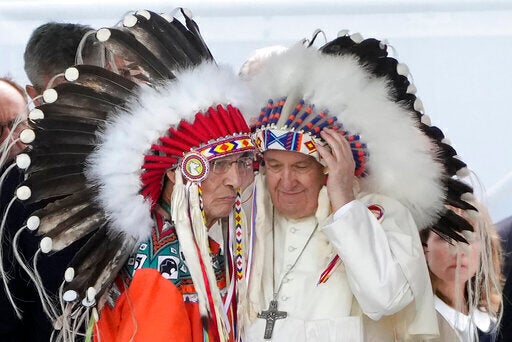The Vatican has repatriated 62 artifacts to Indigenous communities in Canada, marking a significant step in the Catholic Church’s ongoing efforts to address its historical role in the suppression of Indigenous cultures across the Americas.
The items were formally handed over to a delegation from the Canadian Conference of Catholic Bishops during a recent audience.
A joint statement from the Vatican and the Canadian church described the return as a “gift” and a “concrete sign of dialogue, respect and fraternity.”
The pieces originate from the Vatican Museum’s ethnographic collection, known as the Anima Mundi museum.
This collection has long been a source of contention amid wider …
The Vatican has repatriated 62 artifacts to Indigenous communities in Canada, marking a significant step in the Catholic Church’s ongoing efforts to address its historical role in the suppression of Indigenous cultures across the Americas.
The items were formally handed over to a delegation from the Canadian Conference of Catholic Bishops during a recent audience.
A joint statement from the Vatican and the Canadian church described the return as a “gift” and a “concrete sign of dialogue, respect and fraternity.”
The pieces originate from the Vatican Museum’s ethnographic collection, known as the Anima Mundi museum.
This collection has long been a source of contention amid wider debates concerning the restitution of cultural goods acquired from Indigenous peoples during colonial periods.
The majority of the items within the Vatican’s collection were originally dispatched to Rome by Catholic missionaries for a prominent 1925 exhibition held in the Vatican gardens.

Pope Francis dons a headdress during a meeting with Indigenous communities, including First Nations, Metis and Inuit, at Our Lady of Seven Sorrows Catholic Church in Maskwacis, near Edmonton, Canada, in July 2022 (AP)
The Vatican insists the items were “gifts” to Pope Pius XI, who wanted to celebrate the church’s global reach, its missionaries and the lives of the Indigenous peoples they evangelized.
But historians, Indigenous groups and experts have long questioned whether the items could really have been offered freely, given the power imbalances at play in Catholic missions at the time.
In those years, Catholic religious orders were helping to enforce the Canadian government’s forced assimilation policy of eliminating Indigenous traditions, which Canada’s Truth and Reconciliation Commission has called “cultural genocide.”
Part of that policy included confiscating items used in Indigenous spiritual and traditional rituals, such as the 1885 potlatch ban that prohibited the integral First Nations ceremony. Those confiscated items ended up in museums in Canada, the U.S. and Europe, as well as private collections.
Negotiations on returning the Vatican items accelerated after Pope Francis in 2022 met with Indigenous leaders who had traveled to the Vatican to receive his apology for the church’s role in running Canada’s disastrous residential schools.

Pope Francis issues a historic apology for the Catholic Church’s cooperation with Canada’s ‘catastrophic’ policy of Indigenous residential schools (AP)
During their visit, they were shown some objects in the collection, including an Inuit kayak, wampum belts, war clubs and masks, and asked for them to be returned.
Francis later said he was in favor of returning the items and others in the Vatican collection on a case-by-case basis, saying: “In the case where you can return things, where it’s necessary to make a gesture, better to do it.”
The Vatican said Saturday the items were given back during the Holy Year, exactly 100 years after the 1925 exhibition where they were first exhibited in Rome.
“This is an act of ecclesial sharing, with which the Successor of Peter entrusts to the Church in Canada these artifacts, which bear witness to the history of the encounter between faith and the cultures of the Indigenous peoples,” said the joint statement from the Vatican and Canadian church.
It added that the Canadian Catholic hierarchy committed to ensuring that the artifacts are “properly safeguarded, respected and preserved.“
Officials had previously said the Canadian bishops would receive the artifacts with the explicit understanding that the ultimate keepers will be the Indigenous communities themselves.